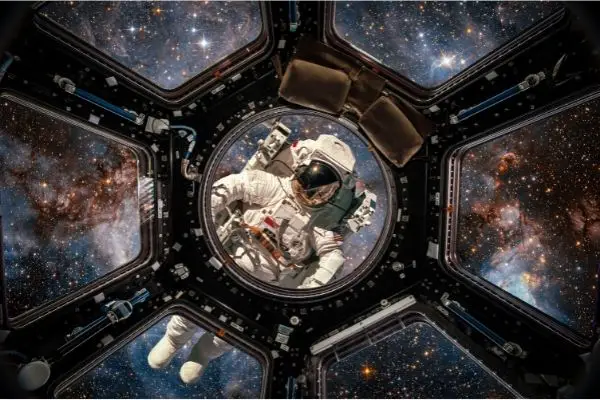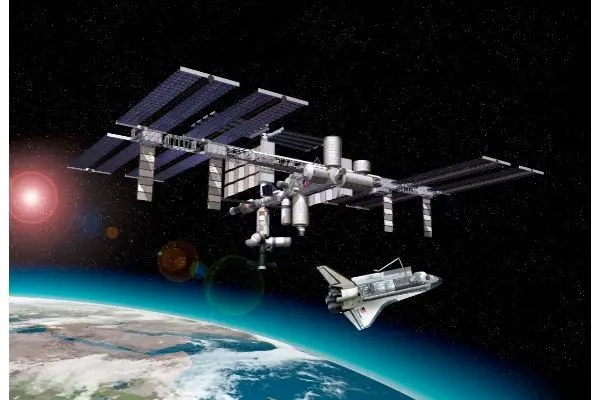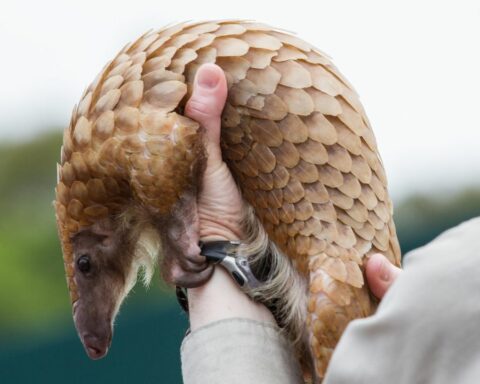International Space Station is a joint space project of multiple nations in which a large modular platform is put into space orbiting around the earth. We have gathered a complete set of International Space Station Facts for Kids, you are going to learn about what is ISS, how was it built, when was it launched, average altitude, cost, structure, its components, scientific research, astronauts, and their daily life, gravity at ISS, size, location, speed, and many other interesting International Space Station Facts.
International Space Station Facts For Kids
What Is ISS (International Space Station)
- International Space Station is a large modular space station revolving in low earth orbit.
- It is a habitual artificial satellite where crews of astronauts and cosmonauts stay.
- It is a unique science laboratory where scientific research is conducted in various fields of science.
- It is a multinational project and several nations collaborated to build and use it.
- The space station is composed of components that were assembled in space.
- It travels at a speed of 17,500 mph.
- It revolves around the Earth at an average elevation of about 250 miles.
- Space agencies (especially NASA) use the space station to acquire more knowledge about working and living in space.
What Does ISS Mean(ISS Stands For)
- The “ISS” is most commonly used as an acronym for the International Space Station.
- This acronym is also used for many other things, such as:
- Information System Services
- Institute for Security Studies
- Institute for Southern Studies
- Information Systems Security, etc.
How Much Did The ISS Cost – International Space Station Cost
- The International Space Station cost $150 billion.
- To operate the ISS, NASA spends about $3 to $4 billion a year.
International Space Station Launch
- The International Space Station was launched on 20 November 1998.
How Old Is The International Space Station?
- In November 1998, the first part of the space station was launched, which is known as the Zarya module or the Functional Cargo Block (FCB). It was launched by a Russian rocket.
- The space shuttle Endeavour, which was bringing the U.S. Unity Node met Zarya in orbit after about two weeks of its launch. The crew connected the U.S. Unity Node to Zarya.
- Over the next two years, more pieces were attached to the station before it was ready for people to stay there.
- On 2 November 2000, the space station received the first crew and people have been staying there ever since.
- Over time, more pieces were attached to the space station and its construction was completed in 2011.
Where Is The International Space Station – ISS Location
- Every day, the International Space Station completes several orbits around the Earth.
- The exact location of the Space Station can be found on https://spotthestation.nasa.gov.
What Is The Altitude Of The ISS
- The International Space Station (ISS) is orbiting at an average altitude of about 250 miles.
What Orbit Is The ISS In
- The International Space Station (ISS) is in Low Earth Orbit.
Inclination Angle Of ISS
- ISS rotates around the Earth at a 51.6° inclination.
- This angle covers about 90% of the Earth’s populated area.
Finding The Space Station – Seeing The International Space Station
- The International Space Station can be observed from more than 6,700 locations throughout the world.
- To find out when the Space Station will be passing overhead, visit https://spotthestation.nasa.gov.
- Sign up for the email or text alerts to learn more about the visibility of the Space Station in the neighborhood.
ISS Viewing By Zip Code
- To view the International Space Station by zip code, visit https://spotthestation.nasa.gov and enter your location to find out when the Space Station will be flying over.
What Is The Purpose Of The International Space Station – ISS Purpose – What Does The ISS Do
- The main purpose of the space station is a long-term exploration of space and to benefit people on the Earth.
- Initially, the Space Station was intended to be a laboratory, factory, and observatory, which would be a staging base for the possible missions to Moon, Mars, and asteroids in the future.
- However, NASA and Roscosmos did not envision all the uses in their initial memorandum of understanding.
- Additional roles of educational, commercial, and diplomatic purposes were assigned to the Space Station in the 2010 United States National Space Policy.
Scientific Research On International Space Station – ISS Research – ISS Lab
- The International Space Station serves as a platform where scientific research is conducted.
- Research is done in a wide variety of fields, such as astronomy, astrobiology, material science, physical sciences, meteorology, space weather, and human research (space medicine and life sciences).
- On Earth, scientists have well-timed access to the data and they can suggest experimental modifications to the crew if needed.
- The Alpha Magnetic Spectrometer (AMS) is the most remarkable experiment conducted on the ISS. The purpose of this experiment was to detect dark matter and to find the answers to fundamental questions about our universe.
- Medical research is conducted on the ISS to know more about the influence of long-term space exposure on the human body, such as bone loss, muscle atrophy, and fluid shift. The achieved data will be used to find out whether long-duration human spaceflight and space colonization is probable.
- Medical research on the ISS is conducted on the behalf of the National Space Biomedical Research Institute (NSBRI). The most prominent project among these is the Advanced Diagnostic Ultrasound in Microgravity, in which ultrasound scans are performed by the astronauts under the instructions of remote experts. The project is based to diagnose and treat medical conditions in space.
- In 2011, the completion of the US Orbital Segment caused a dramatic increase in astronomy, remote sensing of the Earth, and deep space research on the ISS. Over more than 20 years of the ISS program, researchers on the ISS and the Earth have examined ozone, aerosols, lightning, oxides in the atmosphere of the Earth, cosmic rays, cosmic dust, dark matter, and antimatter in the universe.
How Was The ISS Built – ISS Manufacturing – International Space Station Construction – ISS Construction
- The International Space Station is a collaborative project of many nations. So the manufacturing of its components was carried out in various countries.
- Started in the mid-1990s, the US components of the Space Station (Destiny, Unity, the Integrated Truss Structure, and the Solar Arrays) were manufactured at the Marshall Space Flight Center and the Michoud Assembly Facility. The final assembly and processing of these components were carried out in the Neil Armstrong Operations and Checkout Building (O&C) and the Space Station Processing Facility (SSPF).
- The Russian components (Zarya, Zvezda, Pirs, Poisk, and Rassvet) were constructed at the Khrunichev State Research and Production Space Center in Moscow. Initially, Zvezda was constructed as a component for the Soviet space station project Mir-2, in 1985. However, it was never launched and instead incorporated into the ISS as its service module.
- The European components (Columbus, Harmony, Tranquility, the Leonardo MPLM, and the Cupola) were manufactured by the European Space Agency (ESA). The Columbus module was constructed at the Astrium Space Transportation facilities in Germany with many other contractors all over Europe. The other modules were initially built at the Thales Alenia Space factory in Italy and then delivered through aircraft to the John F. Kennedy Space Center SSPF for launch processing.
- The Japanese Experiment Module (Kibō) was manufactured at the NASDA (now known as JAXA), Tsukuba Space Center (TKSC), and the Institute of Space and Astronautical Science (ISAS). The Kibo was then transported to SSPF for launch processing.
- The Mobile Servicing System (composed of Canadarm2 and the Dextre) was built at various factories in Canada and the USA under contract by the Canadian Space Agency.
ISS Assembly – International Space Station Assembly
- The assembly of the International Space Station (ISS) was started in November 1998.
- The launching and docking of all the Russian modules (except Rassvet) was carried out robotically.
- While all the other modules were delivered through the Space Shuttle, which needed installation. Crew members of the Space Shuttle used Canadarm2 (SSRMS) robotic system and extravehicular activities (EVAs) to install modules to the ISS. As of 5 June 2011, the crew members added 159 components in more than 1,000 hours of EVA.
- During the assembly of the Space Station, the beta angle of the station was carefully considered all the time.
- The overall assembly process of the Space Station was completed in more than 30 missions.
How Long Did It Take To Build The ISS
- The construction of the ISS was started on 20 November 1998, and completed on 5 June 2011.
- So it took 12 years and 7.5 months to build the ISS.
How Big Is The International Space Station – ISS Size
- The size of the International Space Station is equal to two Boeing 747 jetliners or a house with five bedrooms.
- Its weight on the Earth would be almost a million pounds.
- If the International Space Station is measured from the edges of its solar arrays, its size would be equal to the area of a football field.
How Big Is ISS Living Space
- The living space of the International Space Station is equal to a five-bedroom house, which can accommodate a crew of 6 people as well as visitors.
How Big Is The International Space Station Inside
- From the inside, the International Space Station has a total space of 932 cubic meters.
- Two-third of the total space is used for storage and equipment.
International Space Station Size Comparison
- The volume of the International Space Station is equal to about two Boeing jetliners.
- From the outside, the total area of the space station from the edges of its solar arrays would cover a football field.
- Its inside space is about the same as a soccer field.
- Its weight is approximately the same as 280 cars.
International Space Station Dimensions
- According to NASA, the length of the fully complete International Space Station will measure 74 meters and its width will be 110 meters.
- Its weight is about 420 tonnes.
ISS Structure – International Space Station Structure
- The International Space Station is a modular space station, which means modules can be added or removed from the existing structure.
- The structure of all the major components of the Space Station is shown in the following diagram:
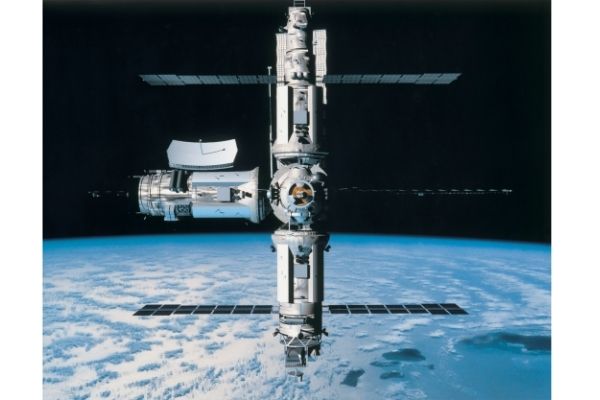
ISS Components
- ISS is composed of many components, which have shapes like spheres, canisters, beams, triangles, and broad flat panels.
- The modules of the space station are shaped like spheres and canisters. These are the working and living areas of the astronauts. The Russian modules Zarya and Zvezda are combinations of canisters and spheres.
- The truss of the Space Station is made up of many beams and triangular structures. The truss serves as the backbone of the Space Station.
- Panels are broad flat surfaces that cover large regions. There are two types of panels on the Space Station; solar panels are used to get sunlight and convert its energy into electricity, while radiators are panels used to eliminate extra heat created in the Station.
- A Robotic arm, known as the Remote Manipulator System, is a component of the Space Station that is used in the construction of the Station via grappling and moving modules or moving astronauts into position to work.
ISS Modules – International Space Station Modules
There are 16 pressurized modules on the ISS. The following is a brief description of each module:
Zarya
- Zarya is the first module of the International Space Station that was launched in 1998.
- It is also known as the Functional Cargo Block and provided electric power, propulsion, storage, and guidance to the Space Station during the starting stages of assembly.
Unity
- Unity is the first module of the International Space Station built by the United States.
- It is also known as Node 1. It connects the U.S and the Russian parts of the Space Station and is the place where the crew eats meals together.
Zvezda
- Zvezda is the Russian module of the ISS and is also known as Zvezda Service Module.
- It is the third module of the Space Station and was launched in 2000.
- It provides all the life support systems for the crew and also has living quarters for the two members of the crew.
Destiny
- Destiny is a U.S module of the ISS launched in 2001.
- It is a laboratory and is also known as the U.S Lab.
- On the Space Station, Destiny provides the main operating facility for the research payloads of the United States.
Quest
- Quest Airlock is the major airlock for the International Space Station.
- It was launched in 2001 and was previously called the Quest Joint Airlock Module.
- It was designed for performing spacewalks with both; NASA’s Extravehicular Mobility Unit spacesuits and the Rusian Orlan Spacesuits.
Pirs and Poisk
- Pirs and Poisk are two Russian docking modules of the ISS.
- These were launched in 2001 and 2009 respectively.
Harmony
- Harmony is a U.S module of the ISS, which is also known as Node 2.
- This module serves as the “utility hub” of the Space Station and connects the laboratory modules of the U.S, Europe, and Japan.
- This module provides electric power and electronic data as well as accommodates the sleeping cabins of four crew members.
Tranquility
- The Tranquility module of ISS was launched in 2010.
- It is also known as Node 3.
- This module has life support and environmental control systems, tools for exercise, a toilet, and an observation cupola.
Columbus
- The Columbus module of the ISS is a contribution by the European Space Agency.
- This module was launched in 2008 and is a science laboratory.
Kibo
- Kibo is the nickname of the Japanese Experiment Module (JEM), which is a science module of the ISS.
- It is a Japanese module and was developed by JAXA.
Cupola
- The copula is an observatory module of the International Space Station that was built by the European Space Agency.
- This module has seven windows which are used for dockings, conducting experiments, and for the observations of the Earth.
Rassvet
- Rassvet is a Russian module of the ISS that is mainly used for cargo storage.
- For visiting spacecraft, this module also serves as a docking port.
- This module is also known as Mini-Research Module 1 (MRM-1) and was launched in 2010.
Leonardo
- The Leonardo Permanent Multipurpose Module (PMM) is the ISS module mainly used for the storage of supplies, spares, and waste on the Space Station.
Bigelow Expandable Activity Module (BEAM)
- Bigelow Expandable Activity Module (BEAM) is an expandable space station module.
- It is an experimental module and was developed for testing as a temporary module on the ISS.
Bishop Airlock Module
- The Bishop Airlock Module was launched to the ISS in 2020.
- The purpose of this module is to deploy small satellites and other payloads for NASA, CASIS, and other customers.
International Space Station Astronauts
- There are more than 50 Astronauts, who visited and stayed in the International Space Station.
- They belong to 19 countries.
What Astronauts Are In Space Right Now
Right now, astronauts (crew members) of the “Expedition 65” are in the International Space Station. They are:
- Shannon Walker (USA)
- Michael Hopkins (USA)
- Victor Glover (USA)
- Soichi Noguchi (Japan)
- Oleg Novitsky (Russia)
- Pyotr Dubrov (Russia)
- Akihiko Hoshide (Japan)
- Shane Kimbrough (USA)
- K. Megan McArthur (USA)
- Thomas Pesquet (France)
What Do Astronauts Do On The ISS
- On the ISS, astronauts do science experiments that need their input, monitor projects that are controlled from the Earth, and take part in medical experiments to determine how well their bodies would adjust while living in space for a long time.
What Do Astronauts Wear In The Space Station
- Inside the Space Station, the astronauts wear similar clothes as they wear on the Earth.
- However, when going on the spacewalks, they wear spacesuits. The spacesuits are of two types; NASA’s Extravehicular Mobility Unit spacesuits and the Rusian Orlan Spacesuits.
- The spacesuit is more than a cloth and provides environmental protection, life support, communications, and mobility for astronauts performing spacewalk or Extravehicular activity in the Earth Orbit.
How Do Astronauts Get To The ISS
- The Russian spacecraft ‘Soyuz’ takes astronauts to the ISS.
- This spacecraft also brings them back to Earth.
- Soyuz has a cabin for three people to travel in it.
- This spacecraft also takes food and water to the Space Station.
What Does The International Space Station Look Like – What Does The ISS Look Like From Earth – ISS From Earth – International Space Station From Earth – International Space Station View From Earth
- The International Space Station looks like a plane from the Earth.
- It is the brightest man-made object in the night sky.
- It will be observed as a steady white dot of light that is not blinking.
Inside The International Space Station – View Inside Space Station – ISS Inside View – Interior Of International Space Station
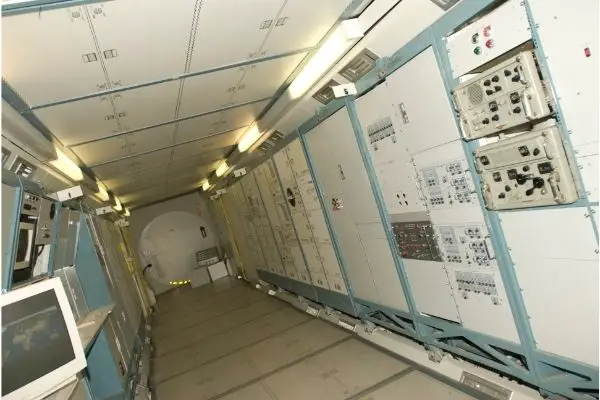
Bedroom International Space Station Inside
- There are no bedrooms in the ISS.
- The astronauts use crew cabins or quarters for sleeping.
- A crew cabin is big enough for a person and has a sleeping bag, in which an astronaut sleeps.
How Astronauts Sleep In The ISS
- After a long working day, astronauts need a good night’s sleep.
- At a certain time, the crew members go to bed, then wake up and get ready for work again.
- There is no ‘up or down’ in space. However, there is microgravity due to which the astronauts are weightless and can sleep in any direction.
- When sleeping, they attach themselves to a wall or something else to not float around and jolt into something in sleep.
- Eight hours of sleep is generally scheduled at the end of each mission day for an astronaut.
- Similar to the Earth, an astronaut may wake up in the middle of sleep to use the toilet.
- The sleep pattern of an astronaut can be disturbed by different things, such as motion sickness or excitement.
- Astronauts reported that they have dreams and nightmares while sleeping in space.
- Some are also reported snoring during sleep.
Toilet At The International Space Station
- ISS has two space toilets, located in the Zvezda and Tranquility modules.
- Both the toilets are of Russian designs and use fan-driven suction systems to direct the waste in a weightless environment, which is similar to the Space Shuttle Waste Collection System.
- The toilet seat is equipped with restraining bars that are spring-loaded to ensure a good seal.
- There is a lever in the toilet, which operates the slides of a suction-hole to open and a powerful fan. The powerful stream of air carries away the waste.
- Solid waste is collected in bags and stored in containers made up of aluminum. When a container becomes full, it is transferred to a Progress spacecraft which then discards it.
- A hose in the front of the toilet evacuates the liquid waste. It is then transferred to the Water Recovery System, which recycles it into drinking water.
Hygiene At The International Space Station
- Showers were introduced on Space Stations during the early 1970s on Skylab and Salyut-3.
- However, showers are not featured on the International Space Station, instead, water jets and wet wipes are used. The soap they use is released from a container similar to a toothpaste tube.
- An edible toothpaste and rinse-less shampoo are provided to the crew to save water.
How Heavy Is The International Space Station
- The weight of a fully complete International Space Station will be equal to the weight of more than about 330 automobiles.
How Much Does The ISS Weigh – ISS Mass
- The weight of a fully complete International Space Station will be equal to approximately 420,000 kilograms (925,000 pounds).
International Space Station Length
- According to NASA, the length of a complete International Space Station will measure 243 feet (74 meters).
International Space Station Width
- According to NASA, the length of a fully complete ISS will measure 361 feet (110 meters).
How High Is The ISS – International Space Station Altitude – ISS Orbit Altitude
- According to NASA, the International Space Station orbits at an altitude of between 370 and 460 Kilometers above the surface of the Earth.
How High Is The ISS In Miles
- In miles, the altitude of the ISS is between 320 to 286 miles.
How Far Is The Space Station From Earth
- The Space Station is between 370 and 460 Kilometers far from the Earth.
- On average, it is far from the Earth as Washington DC is far from New York, NY.
Gravity On International Space Station – Gravity On ISS – Gravity In Space Station
- At the elevation of the ISS, gravity is about 90% stronger than the Earth’s surface.
- However, objects are in the state of continuous freefall in orbit, which results in an apparent state of weightlessness.
Why Astronauts On The International Space Station Feel Weightless
- Astronauts on the International Space Station feel weightless because there is no force to counteract the gravitational force.
- So the astronaut is falling continuously.
- As the astronaut is also moving in a forward direction with a very fast speed, he does not crash into the Earth but rather falls continuously around the Earth.
- This condition creates an apparent state of weightlessness on the ISS.
How Long Does It Take To Get To ISS – ISS Travel Time
- A Soyuz spacecraft generally takes about 6 hours to follow and catch the International Space Station.
- In this process, a Soyuz must complete approximately 4 orbits around the Earth.
International Space Station Expeditions
- A total of 64 expeditions were made to the International Space Station.
- The current expedition is “Expedition 65”, which started on 17 April 2021 and will end in October 2021.
ISS Life Support – ISS Life Support System
- Life support systems are a crucial part of the International Space Station.
- The most vital life support systems include; the atmosphere control system, the water supply system, the sanitation and hygiene equipment, facilities of the food supply, and equipment for fire detection and suppression.
- The atmosphere onboard the Space Station is adjusted similarly to that of the Earth’s atmosphere. The air pressure on the Space Station is 101.3 kPa (14.69 psi), which is similar to the air pressure on the sea level at Earth.
- The earth-like atmosphere is beneficial to the comfort of the crew and is extremely safer than the atmosphere of pure oxygen, which has a higher risk of catching fire.
- Onboard the Space Station, the Elektron system on the Russian module Zvezda and a similar system on the U.S. module Destiny generate oxygen.
- The Vozdukh system in Zvezda removes carbon dioxide from the air.
- The activated charcoal filters remove other by-products of the human metabolism, such as ammonia from sweat and methane from the intestines.
What Powers The International Space Station – ISS Power Source
- Sunlight is the overall power source of the International Space Station.
- The distance of the ISS from the sun is 149 million kilometers (93 million miles).
- At this distance, one square meter of the surface area receives about 1.367 kilowatts of power from the sun.
- Arrays of solar cells collect this power from the sun.
ISS Power Generation
- The electrical system of the International Space Station uses solar cells to convert sunlight to electric power.
- According to NASA, a total of 262,400 solar cells are assembled in arrays that cover an area of about 2,500 square meters (27,000 square feet).
- The electric power it generates is enough for 10 average size homes with a power supply of 110 kilowatts.
Space Station Solar Panels
- A large number of solar panels are arranged in four sets of arrays on the ISS.
- The solar arrays cover about an acre surface, which is more than half of the area of a football field.
How Fast Does The ISS Travel – International Space Station Speed – What Is The Speed Of The International Space Station
- The International Space Station travels at a speed of 7.66 kilometers per second.
How Often Does The ISS Orbit The Earth
- The International Space Station passes over the same location on Earth every 3 days.
- It orbits the Earth 16 times per day. So the astronauts on the ISS can observe 16 sunrises and 16 sunsets every day.
How Long Does It Take ISS To Orbit Earth
- To complete one orbit around the Earth, the ISS takes only about 90 minutes.
ISS Speed Mph
- In mph (miles per hour), the traveling speed of ISS is 17,130.
ISS Orbit Speed – ISS Speed Around Earth – ISS Rotation Speed
- The speed of the ISS it travels around the Earth is 7.66 km/s (5 miles per second).
ISS Orbital Velocity
- The orbital velocity of the ISS is 7.66 km/s.
ISS Communication
- There are a total of five communication systems on the ISS with cutting-edge technology.
- The initial communication system of the US Orbital Segment (USOS) of the ISS was the “Early Comm”. However, it was then replaced by two separate radio links: the S-band and the Ku-band (audio, video, and data) sub-systems.
- The S-band transmits audio, commands, files, and telemetry between the Space Station and the Mission Control Center Houston (MCC-H) through the Tracking and Data Relay Satellite System (TDRSS).
- The Audio System is used for the distribution of audio (voice) and Caution-&-Warning Tones on-board the Space Station.
- The UHF system is used for the communication of voice and data between the Space Station, the Orbiter, and the crew-members performing the Extravehicular Activity (EVA).
- The Video Distribution System (VDS) distributes videos on fiber optic-analog lines on-board the Space Station. This system also interacts with the Ku-band system to send videos to the Ground Stations.
- The Russian Orbital Segment (ROS) communicates to the ground directly through the Lira antenna, which is mounted on Zvezda.
- Voskhod-M is another communication system of the Russian Orbital Segment. It enables the internal telephone communications between the Russian modules Zvezda, Zarya, Pirs, Poisk, and the US Orbital Segment (USOS). This system also provides a VHF radio link to the ground control centers through antennas mounted on Zvezda.
International Space Station Internet Speed – Internet Speed On ISS
- The internet speed on the International Space Station is 600 megabit-per-second (Mbps).
What Do They Eat On The International Space Station – ISS Food
- On the International Space Station crew members eat food transported from the Earth.
- Most of the food delivered to the Space Station is vacuum-sealed in plastic bags. Cans are usually avoided because of weight and expensive transportation.
- Crew-members do not regard preserved foods mostly. As the test is reduced at microgravity, so efforts are made to make the food tasty and palatable, for example, more spices are added than regular cooking.
- The crew eagerly awaits the arrival of any spacecraft from the Earth, as it carries fresh vegetables and fruits for them.
- Special care is taken that the food does not produce crumbs. Condiments are usually preferred in the liquid form rather than solid to avoid the contamination of the Station’s equipment.
- There are individual food packages for each crew member. He/she cooks them in the onboard galley.
- The galley has two food warmers, a refrigerator (which was added in November 2008), and a water dispenser that provides both cold and warm water.
- The drinks provided to them are in the form of dehydrated powder, which they mix with water before consumption.
- They sip drinks and soups with straws from the plastic bags.
- They eat solid foods with a fork and knife, which are attached through magnets to a tray otherwise it would float away.
- Any food materials and crumbs that float away are collected to prevent their clogging in the air filters and other equipment of the Space Station.
How Do They Send Food To The International Space Station – ISS Food Delivery
- They send food to the International Space Station through cargo spacecraft.
- The most frequent cargo spacecraft is the Russian “Progress”, which has 2,400 kilograms payload capacity.
- It delivers most of the supplies to the Space Station, such as food, fuel, gas, parts, and other things.
International Space Station Food Source
- The food is delivered to the International Space Station from the Earth through cargo spacecraft.
- Many types of foods are sent to them, from which the astronauts can choose what they want to eat.
What Is The International Space Station Made Out Of
- The common materials used in the ISS are Titanium, Kevlar (a strong, heat-resistant synthetic fiber), and high-grade steel.
- Engineers used these materials to make the structure of ISS strong, light in weight, and puncture-resistant.
View From The International Space Station – View Of Earth From Space Station
- Parts of the Earth are revealed when viewed from the International Space Station.
- As it orbits in low Earth orbit, so the whole planet can not be viewed.
- When passing from the United States, astronauts can observe many parts of the North American continent.
International Space Station Countries Involved – ISS Countries Involved
- The International Space Station is a collaborative project of the following countries:
- United States
- Russia
- Canada
- Japan
- Eleven countries of Europe (Belgium, Denmark, France, Germany, Italy, Norway, The Netherlands, Spain, Switzerland, Sweden, United Kingdom), which are the Member States of the European Space Agency (ESA).
SpaceX And International Space Station
- SpaceX (Space Exploration Technologies Corp.) is an American company that provides aerospace manufacturing and space transportation services.
- The founder of the company is Elon Musk.
- The purpose of the company was to reduce the costs of space transportation and to enable the colonization of Mars.
- SpaceX was the first private company that sent a spacecraft (named Dragon) to the International Space Station on 25 May 2012.
- SpaceX was also the first private company that autonomously docked a spacecraft to the ISS on 3 March 2019.
- On 31 May 2020, SpaceX sent humans to the ISS and became the first private company to do so.
International Space Station Fun Facts
- The International Space Station is the biggest man-made object in space.
- It is the third brightest thing in the sky and can be seen in the night sky with naked eyes.
- The Space Station can be observed from more than 6,700 locations throughout the world.
- The assembly process of the Space Station took about 12.5 years to complete.
- The pressurized modules of the International Space Station hold a pressurized atmosphere similar to the small canisters of carbonated drinks, which efficiently hold the pressurized liquid on the earth.
- The Russian crew members of the Space Station are called Cosmonauts, while the crew members of the United States, Canada, Europe, and Japan are called Astronauts.
- The wingspan of the solar arrays of the Space Station is 109 meters (356 feet), which is longer than the Airbus A380 (80 meters), the largest passenger aircraft in the world.
Interesting Facts About The ISS
- The ISS rotates 16 times around the Earth in one day, so the crew members can observe 16 sunrises and 16 sunsets every day.
- On the Space Station, the temperature during the periods of daylight reaches about 200 ℃, while it drops to about -200 ℃ at night time.
- The individuals that have visited the ISS are 242 and belong to 19 different countries.
- A crew of 6 people live and work on the International Space Station while traveling at the speed of 5 miles per second.
- The ISS completes one orbit around the Earth about every 90 minutes.
- U.S. Astronaut Peggy Whitson set the U.S. record of spending the most time in space, which was 665 days on September 2, 2017.
- Since December 1998, Astronauts and Cosmonauts have conducted 232 spacewalks for the construction, maintenance, and up-gradation of the Space Station.
- The living and working area in the ISS is larger than a six-bedroom house. There are 6 sleeping cabins, two bathrooms, a gym, and a bay window that provides a 360-degree view.
- The wire that connects the electrical power system on the ISS is eight miles long.
- The Water Recovery System on the ISS reduces the dependence of crew members on the water delivered through cargo spacecraft by 65%. So they need about 1/3 gallon of water a day instead of one gallon a day.
How Many Space Stations Are There
- There is only one space station in the world, that is the International Space Station.



